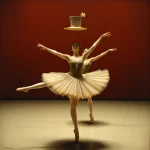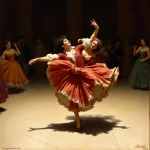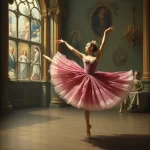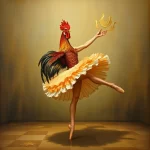Ballet: The Three-Cornered Hat (Manuel de Falla, 1919)

Introduction
Ballet, as an art form, has a rich history of storytelling through dance, music, and visual spectacle. One of the notable works in this genre is “The Three-Cornered Hat” (El sombrero de tres picos), a ballet composed by Manuel de Falla in 1919. This ballet is a vibrant and humorous piece that combines Spanish folk music and dance with classical ballet techniques. The choreography was crafted by Léonide Massine, and the ballet premiered on July 22, 1919, at the Alhambra Theatre in London. The plot revolves around a miller, his beautiful wife, and a lecherous magistrate, weaving a tale of love, jealousy, and cunning.
Historical Background
Creation and Development
The creation of “The Three-Cornered Hat” occurred during a period of significant cultural and artistic transformation in Europe. The early 20th century was marked by a fascination with national identities and folklore, which influenced many artists and composers. Manuel de Falla, a prominent Spanish composer, drew inspiration from Spanish literature and folk traditions. The ballet is based on Pedro Antonio de Alarcón’s novella “El sombrero de tres picos,” which itself is rooted in Andalusian folklore.
The collaboration between Falla and Massine was pivotal in bringing this ballet to life. Massine, a choreographer for Sergei Diaghilev’s Ballets Russes, was known for his innovative and expressive choreography. The partnership also included the renowned artist Pablo Picasso, who designed the sets and costumes, adding a visual richness to the production.
Premiere and Reception
“The Three-Cornered Hat” premiered on July 22, 1919, at the Alhambra Theatre in London. The initial reception was overwhelmingly positive, with critics and audiences praising the ballet’s vibrant energy, humor, and the seamless integration of music, dance, and visual art. The ballet quickly became a staple in the repertoire of Ballets Russes and has since been revived numerous times by various companies around the world.
Synopsis of the Ballet
Act I Summary
The ballet opens with a lively scene at a mill, where the Miller and his Wife are introduced. The Miller’s Wife is known for her beauty, and the local Magistrate becomes infatuated with her. The Miller and his Wife share a playful and loving relationship, which is evident in their dances. The Magistrate, wearing his distinctive three-cornered hat, attempts to woo the Miller’s Wife, but she cleverly rebuffs his advances.
Act II Summary
In the second act, the Magistrate devises a plan to arrest the Miller and have him imprisoned, hoping to take advantage of the Miller’s Wife in his absence. However, the Miller’s Wife outsmarts the Magistrate once again. She tricks him into falling into a river, and the Miller escapes from prison with the help of his friends. The act is filled with humorous and dramatic moments, showcasing the cunning and resourcefulness of the Miller’s Wife.
Finale
The ballet concludes with a festive celebration at the mill. The Miller and his Wife are reunited, and the villagers join in a joyful dance. The Magistrate, humiliated and defeated, is chased away. The finale is a triumphant and exuberant display of dance and music, highlighting the themes of love, loyalty, and justice.
Musical Composition
Composer’s Role
Manuel de Falla’s contribution to “The Three-Cornered Hat” is significant, as his score is a masterful blend of classical music and Spanish folk elements. Falla’s music captures the essence of Andalusian culture, with its rhythmic vitality and melodic richness. Notable pieces within the score include the “Dance of the Miller’s Wife” and the “Final Dance,” both of which are celebrated for their lively and evocative character.
Musical Themes and Motifs
The score of “The Three-Cornered Hat” is characterized by recurring musical themes and motifs that enhance the narrative and emotional depth of the ballet. Falla employs traditional Spanish dance forms such as the fandango and seguidilla, infusing them with his unique compositional style. The music not only supports the choreography but also adds layers of meaning to the characters and their interactions.
Famous Recordings and Performances
Several iconic recordings of “The Three-Cornered Hat” have been made over the years, featuring renowned conductors and orchestras. One notable recording is by the London Symphony Orchestra conducted by Sir Simon Rattle, which captures the vibrancy and nuance of Falla’s score. The ballet has also been performed by prestigious companies such as the Royal Ballet and the Paris Opera Ballet, each bringing their own interpretation to the work.
Choreography and Dance
Choreographer’s Vision
Léonide Massine’s choreography for “The Three-Cornered Hat” is a testament to his innovative approach to dance. Massine sought to create a ballet that was both entertaining and artistically sophisticated, blending classical ballet techniques with Spanish folk dance. His choreography is characterized by its dynamic energy, expressive gestures, and intricate footwork, all of which reflect the story’s humor and drama.
Signature Dance Numbers
Key dance numbers in “The Three-Cornered Hat” include the “Fandango” and the “Jota,” both of which are central to the ballet’s narrative and thematic development. The “Fandango” is a flirtatious and spirited dance performed by the Miller’s Wife, showcasing her charm and wit. The “Jota,” performed in the finale, is a celebratory dance that brings together the entire cast in a display of communal joy and triumph.
Notable Interpretations
Over the years, different productions of “The Three-Cornered Hat” have offered unique interpretations of Massine’s choreography. Some have emphasized the ballet’s comedic elements, while others have focused on its folkloric and cultural aspects. Notable interpretations include those by the Ballet Nacional de España, which highlighted the ballet’s Spanish roots, and the American Ballet Theatre, which brought a contemporary sensibility to the work.
Characters and Roles
Main Characters
- The Miller: A hardworking and clever man who loves his wife deeply. He is central to the story’s conflict and resolution.
- The Miller’s Wife: A beautiful and resourceful woman who outsmarts the Magistrate’s advances. Her character is both charming and cunning.
- The Magistrate: A lecherous and pompous figure who becomes infatuated with the Miller’s Wife. His attempts to woo her provide much of the ballet’s humor.
Supporting Characters
- The Corregidor’s Servants: They assist the Magistrate in his schemes but are often outwitted by the Miller and his Wife.
- The Villagers: They play a crucial role in the ballet’s communal scenes, adding to the festive and lively atmosphere.
Famous Dancers
Several renowned dancers have portrayed the lead roles in “The Three-Cornered Hat.” Notable among them are Rudolf Nureyev, who brought a charismatic presence to the role of the Miller, and Alicia Alonso, whose portrayal of the Miller’s Wife was both graceful and spirited. These performances have left a lasting impact on the ballet’s legacy.
Cultural and Artistic Impact
Influence on Ballet and Dance
“The Three-Cornered Hat” has had a significant influence on the world of ballet and dance. Its successful integration of folk elements into classical ballet opened new avenues for choreographers and composers. The ballet’s emphasis on character-driven storytelling and humor also inspired subsequent works in the genre.
Cultural Significance
The ballet holds a special place in popular culture and has been referenced in various forms of media. Its vibrant depiction of Spanish culture has made it a symbol of national pride. Additionally, adaptations of the ballet have appeared in film and theater, further cementing its cultural significance.
Legacy and Revivals
“The Three-Cornered Hat” continues to be performed and celebrated today. Major revivals by companies such as the Royal Ballet and the Paris Opera Ballet have kept the work alive for new generations of audiences. Modern adaptations have also explored different aspects of the ballet, ensuring its enduring relevance.
Iconic Productions
Historic Productions
One of the most famous historical productions of “The Three-Cornered Hat” was its premiere by the Ballets Russes in 1919. This production featured the original choreography by Massine, music by Falla, and set designs by Picasso. The collaboration of these artistic giants made it a landmark event in the history of ballet.
Contemporary Productions
Recent productions of “The Three-Cornered Hat” have brought fresh perspectives to the ballet. Companies such as the American Ballet Theatre and the Ballet Nacional de España have reinterpreted the work, incorporating contemporary dance techniques and modern staging. These productions highlight the ballet’s timeless appeal and adaptability.
Production Design
The set and costume design for “The Three-Cornered Hat” have always been integral to its success. Picasso’s original designs were groundbreaking, combining bold colors and abstract forms to create a visually striking production. Subsequent productions have drawn inspiration from Picasso’s work while also introducing new design elements to reflect contemporary tastes.
Critical Reception and Reviews
Initial Critical Response
At the time of its premiere, “The Three-Cornered Hat” received glowing reviews from critics. They praised the ballet’s innovative choreography, vibrant music, and cohesive artistic vision. The collaboration between Falla, Massine, and Picasso was seen as a triumph, and the ballet quickly became a favorite among audiences.
Modern Reviews
Contemporary critics continue to hold “The Three-Cornered Hat” in high regard. They appreciate its historical significance and its enduring charm. Modern reviews often highlight the ballet’s ability to entertain while also offering a sophisticated artistic experience. The ballet’s relevance today is attributed to its universal themes and its masterful integration of music, dance, and visual art.
Fun Facts and Trivia
Behind-the-Scenes Stories
One interesting anecdote from the production of “The Three-Cornered Hat” involves Picasso’s involvement. The artist was so dedicated to the project that he personally painted some of the backdrops and even helped with costume fittings. His hands-on approach added a unique touch to the production.
Notable Performers
Over the years, many famous dancers have been associated with “The Three-Cornered Hat.” In addition to Nureyev and Alonso, other notable performers include Margot Fonteyn and Mikhail Baryshnikov, both of whom brought their own interpretations to the ballet’s lead roles.
Trivia
- The ballet’s original title was “El corregidor y la molinera,” but it was changed to “The Three-Cornered Hat” to better reflect the central motif of the Magistrate’s hat.
- Manuel de Falla incorporated traditional Spanish instruments such as castanets and tambourines into the score, adding an authentic folk flavor to the music.
- The ballet’s premiere was attended by several prominent figures in the arts, including Igor Stravinsky and Jean Cocteau, who praised the production.
Conclusion
Summary of the Ballet’s Importance
“The Three-Cornered Hat” is a significant work in the world of ballet for its innovative blend of classical and folk elements, its engaging storytelling, and its collaborative artistic vision. The ballet has left a lasting impact on the genre, influencing subsequent works and inspiring generations of dancers and choreographers.
Final Thoughts
Reflecting on “The Three-Cornered Hat,” it is clear that the ballet’s enduring appeal lies in its ability to entertain and captivate audiences while also offering a rich artistic experience. Its themes of love, jealousy, and cunning are universal, and its vibrant music and choreography continue to resonate with audiences today. For those who have not yet experienced this masterpiece, watching a performance or listening to the score is highly recommended.
FAQ
What is the central theme of this ballet?
The central theme of “The Three-Cornered Hat” is the triumph of love and cunning over jealousy and deceit.
Who are the main characters in this ballet?
The main characters are the Miller, his Wife, and the Magistrate.
What is the most famous dance number in this ballet?
The “Fandango” performed by the Miller’s Wife is one of the most famous dance numbers in the ballet.
How long does a typical performance of this ballet last?
A typical performance of “The Three-Cornered Hat” lasts approximately 40-50 minutes.
Are there any modern adaptations of this ballet?
Yes, there have been several modern adaptations that incorporate contemporary dance techniques and staging.
Why is this ballet considered important in the history of dance?
“The Three-Cornered Hat” is considered important for its innovative integration of folk elements into classical ballet, its collaborative artistic vision, and its enduring influence on the genre.





